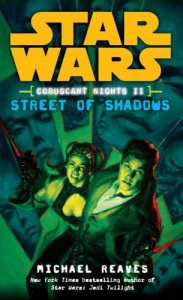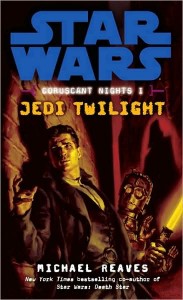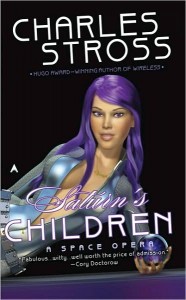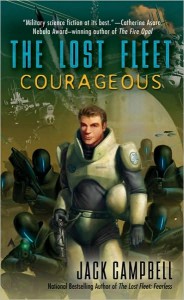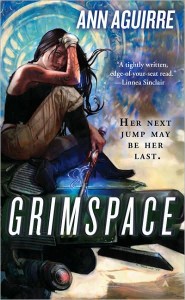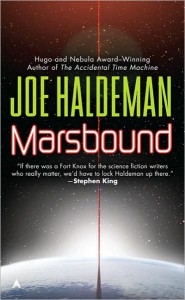 At first, Carmen Dula is thrilled to have the opportunity to travel to Mars with her family, where they’ll be part of opening up mankind’s next great frontier. Once reality sets in — that space travel is long, dull, cramped and uncomfortable — she’s not quite as excited, even with the new friends she’s making along the way, and not even the attentions of the handsome pilot of the John Carter of Mars — their home for the next six months — can entirely cure the feeling that she’s giving up everything she knew for an experience bordering between boring and deadly. But since you can’t exactly turn around if you change your mind, Carmen sucks it up and sets herself to doing the best she can. And thus her journey takes her up the Space Elevator on Earth, to the spaceship in Geosynchronous Earth Orbit, and then to Mars itself.
At first, Carmen Dula is thrilled to have the opportunity to travel to Mars with her family, where they’ll be part of opening up mankind’s next great frontier. Once reality sets in — that space travel is long, dull, cramped and uncomfortable — she’s not quite as excited, even with the new friends she’s making along the way, and not even the attentions of the handsome pilot of the John Carter of Mars — their home for the next six months — can entirely cure the feeling that she’s giving up everything she knew for an experience bordering between boring and deadly. But since you can’t exactly turn around if you change your mind, Carmen sucks it up and sets herself to doing the best she can. And thus her journey takes her up the Space Elevator on Earth, to the spaceship in Geosynchronous Earth Orbit, and then to Mars itself.
There, she finds that even millions of miles from home, people are still the same as always, and the colony administrator in particular takes a very visible dislike to Carmen. Events happen, and before she knows just what she’s doing, Carmen has gone for an unauthorized walk out on the Mars surface, where she discovers something impossibly new and different: humans are not alone on Mars. But these aliens come in peace, or so it seems… that is, until a deadly disease strikes the children of the colony.
Years later, once the wrinkles have been smoothed out between humans and Martians, and a special place has been established where the two species can learn from one another, a deeper, darker mystery is revealed, when intelligent signals are received from one of Neptune’s moons. It seems that the Martians weren’t native to Mars after all, and what’s more, there’s a very specific reason they were placed there, and left to wait for us. Now a plan millennia in the making is about to come to fruition. If Carmen and her allies can’t figure it out in time, it could spell doom for an entire race. Ours.
Marsbound is what I’d call an odd duck of a story, being as it is several very different segments pieced together to create a longer narrative. First you have the story of Carmen’s trip from Earth to Mars, which is very much concerned with the day-to-day minutiae of realistic space travel, and it’s here where Joe Haldeman takes his time to show off the nuts and bolts of a very plausible space program, from the immense Space Elevator stretching from its origination in the Galapagos Islands up into Earth’s orbit, to the ship that carries our heroine and her family to Mars. It’s claustrophobic, dingy, and all too real, unglamourizing space travel and humanizing the people who’ll ultimately be making the trip to help expand the colony. There’s no doubt but that Haldeman, who’s always been a realist and a hard science man, is doing his best to help prepare us for the reality of space travel, as opposed to the fantasized versions which most science fiction writers prefer to work with. In this fashion, he reminds me of Ben Bova, who also excels at integrating human concerns with realistic science fiction. At any rate, there’s a lack of real action in this segment, which focuses on the nitty-gritty details and the reactions of the protagonist to the various changes. It doesn’t let up when we get to Mars, either, as Haldeman projects what a starting colony out on the edge of a new world might be like, how it might function, and what duties will need fulfilling. It’s intriguing, especially since Haldeman has an engaging voice and manages to conveys all of this information without dropping too far into exposition mode.
The next segment picks up at the point when Carmen encounters the so-called Martians, and here’s where the story begins to truly take on its more fantastical elements. We delve into the mystery of a race that’s very much like ours in some regards, and absolutely different in others. This takes us all the way from the moment of First Contact, through the plague which threatens the human children, and ends when that particular issue has been resolved. Shorter than the first segment, it’s got a lot more action and imminent danger to it.
The third and last part of Marsbound picks up several years later, after a new space station, Little Mars, has been built and populated by teams of humans and Martians as they try to understand one another. It’s an odd jump, given that the first two thirds of the book took place over one continuous length of time, and the last third hits fast forward. For any other author, they might have been tempted to make multiple books out of this; Haldeman clearly knew how much time and effort he wanted to invest in this, and didn’t give in to the impulse to expand any further. As for this part of the story, it delves into the mysteries of the Martians’ origins and true purpose, reveals the existence of other intelligences even further out in the solar system, and sets up a clear and present danger to humanity which has to be solved post-haste. There’s an almost breakneck abruptness to the way this unfolds, and the story ends pretty soon after the resolution of the immediate problem, which is a shame in my opinion. Haldeman’s one of those authors capable of setting up fascinating scenarios with engaging characters, enough so that you enjoy spending time with them, so it’s something of a letdown when the story ends.
On the one hand, I found Marsbound to be a compelling, fast-paced read; once I started, I couldn’t put the book down. Its realistic take on space travel, and its grounding in believable science, all told from the viewpoint of a fairly sympathetic character, make for a great read. On the other hand, the pacing seemed off, and the ending almost violently sudden, and I was thus left feeling like something was missing. This may in part be due to its earlier publication as a three-part serial in Analog magazine, which would certainly explain the distinct endings and beginnings between each of the segments. It makes me wonder if it might have been possible to do a little more editing to smooth out the rough edges, and make it more of a fully streamlined book, rather than three portions joined together. However, Haldeman’s one of the great science fiction authors, in my opinion, so maybe I hold him up to standards I wouldn’t expect of a newer generation, so what would be an excellent book from anyone else is just very good coming from him. Despite my moments of disappointment, I found Marsbound to be quite enjoyable, and I’d even be willing to recommend it as a YA book for those teen readers in search of good SF. And definitely, despite any dissatisfaction I might have with the minor technical details, I can’t fault the storyline or the energy, and certainly not the science involved. You can bet that when Haldeman releases another book (I’ve read that he’s working on a sequel to Marsbound) I’ll be there to read it.
Originally reviewed for SF Site, 2008
 Mack Megaton isn’t your average joe on the street. He’s actually a reprogrammed robot built for destruction and world domination who, upon gaining free will, gave up his creator’s megalomanical ways and has gone straight, earning his citizenship one day at a time as an honest taxi driver in Empire City, where weird science reigns supreme. He’s not hero material, that’s for sure. Heck, he barely understands people, and he can’t even tie a bow tie. His therapist thinks he needs to work on his manual coordination, as well as getting out to interact with people more often. But hey, it’s hard for a seven foot tall ex-doomsday machine to get comfortable with people, you know?
Mack Megaton isn’t your average joe on the street. He’s actually a reprogrammed robot built for destruction and world domination who, upon gaining free will, gave up his creator’s megalomanical ways and has gone straight, earning his citizenship one day at a time as an honest taxi driver in Empire City, where weird science reigns supreme. He’s not hero material, that’s for sure. Heck, he barely understands people, and he can’t even tie a bow tie. His therapist thinks he needs to work on his manual coordination, as well as getting out to interact with people more often. But hey, it’s hard for a seven foot tall ex-doomsday machine to get comfortable with people, you know?
